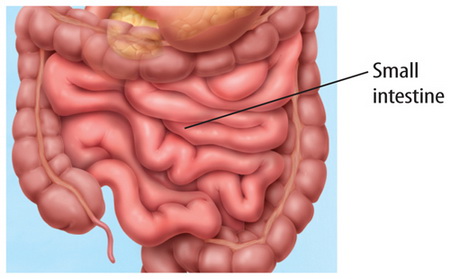What is Small intestine?
Small intestine, a long, narrow, folded or coiled tube extending from the stomach to the large intestine; it is the region where most digestion and absorption of food takes place. It is about 6.7 to 7.6 metres (22 to 25 feet) long, highly convoluted, and contained in the central and lower abdominal cavity. A thin membranous material, the mesentery, supports and somewhat suspends the intestines.
The mesentery contains areas of fat that help retain heat in the organs, as well as an extensive web of blood vessels. Nerves lead to the small intestine from two divisions of the autonomic nervous system: parasympathetic nerves initiate muscular contractions that move food along the tract (peristalsis), and sympathetic nerves suppress intestinal movements.

Three successive regions of the small intestine are customarily distinguished: duodenum, jejunum, and ileum. These regions form one continuous tube, and, although each area exhibits certain characteristic differences, there are no distinctly marked separations between them. The first area, the duodenum, is adjacent to the stomach; it is only 23 to 28 cm (9 to 11 inches) long, has the widest diameter, and is not supported by the mesentery.
Ducts from the liver, gallbladder, and pancreas enter the duodenum to provide juices that neutralize acids coming from the stomach and help digest proteins, carbohydrates, and fats. The second region, the jejunum, in the central section of the abdomen, comprises about two-fifths of the remaining tract. The colour of the jejunum is deep red because of its extensive blood supply; its peristaltic movements are rapid and vigorous, and there is little fat in the mesentery that supports this region. The ileum is located in the lower abdomen. Its walls are narrower and thinner than in the previous section, blood supply is more limited, peristaltic movements are slower, and the mesentery has more fatty areas.
